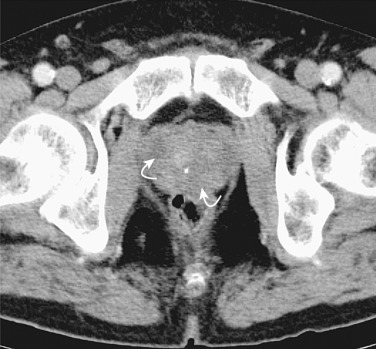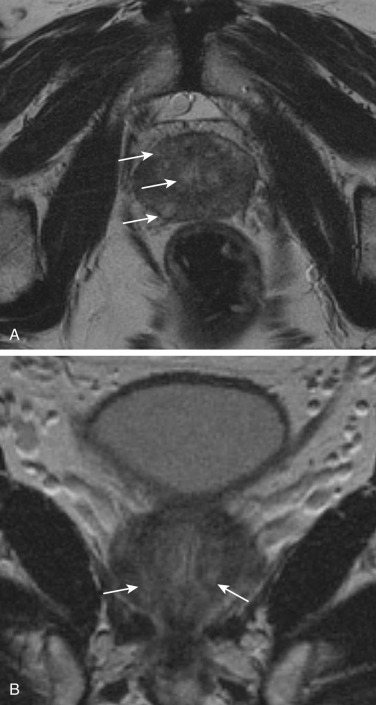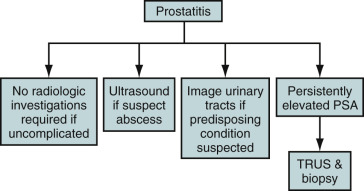Physical Address
304 North Cardinal St.
Dorchester Center, MA 02124
Benign focal lesions of the prostate include benign prostatic hyperplasia (BPH) (see Chapter 72 ), congenital cysts, acquired cysts, prostatitis (acute bacterial, chronic bacterial, chronic pelvic pain syndrome [inflammatory and noninflammatory], and asymptomatic prostatitis), prostatic abscess, and prostatic calcification.
The National Institutes of Health classification of prostatitis syndromes provides a useful conceptual framework. Categories I and II reflect acute and chronic bacterial prostatitis, respectively. Category III, known as chronic prostatitis/chronic pelvic pain syndrome, constitutes the vast majority (>90%) of cases and is divided into IIIA (inflammatory) and IIIB (noninflammatory). Category IV refers to asymptomatic inflammatory prostatitis, usually diagnosed incidentally.
Prostatitis is perhaps the most common urologic complaint in men younger than 50 years of age and affects 11% to 16% of American men over the course of their lifetime.
The presentation of benign prostate disease varies according to the particular pathologic process. For example, acquired prostate cysts and calcification are typically asymptomatic, whereas prostatitis ranges from incidentally detected asymptomatic conditions to symptomatic cases.
Any part of the prostate gland can be involved by prostatitis, abscess, or calcification. Acquired cysts are located in a paramedian distribution. In prostatitis, there is an increased number of inflammatory cells. Cysts and calcifications are benign processes.
The most commonly used diagnostic imaging techniques for prostate evaluation are transrectal ultrasound (TRUS) and MRI. Benign findings such as cysts and calcifications are typically incidental, usually found on routine investigation for other conditions; most benign processes such as BPH and prostatitis require little investigation. TRUS can provide high-resolution images of the prostate and real-time guidance for intervention such as biopsy, aspiration, and drainage, without the use of radiation. Magnetic resonance imaging (MRI) accurately delineates the internal prostatic anatomy but is not routinely used for the investigation of benign prostate lesions owing to its high cost and relatively limited availability. Relative to these modalities, radiography and computed tomography (CT) have limited roles in the evaluation of most prostate processes.
Antibiotics are the mainstay of treatment for prostatitis. Other treatments, including both pharmacologic and nonpharmacologic approaches, have been assessed as potential treatments for chronic prostatitis and pelvic pain syndromes. Prostatic abscess drainage is the only indication for surgical intervention in benign prostatic disease.
Acute bacterial prostatitis is most commonly caused by aerobic gram-negative rods, in particular Escherichia coli and Pseudomonas species. Bacteria may ascend to the prostate by reflux of infected urine into the prostatic duct, by lymphatic or hematogenous dissemination, or during interventions such as prostatic biopsy. Emphysematous prostatitis occurs secondary to infection with gas-forming organisms; while rare, it is associated with high mortality.
Acute bacterial prostatitis is rare and is seen in less than 5% of patients with prostatitis.
Acute bacterial prostatitis usually manifests as an acute illness with fever, chills, lower back and perineal pain, urinary frequency and urgency, and dysuria. Rectal palpation usually reveals an enlarged, exquisitely tender prostate gland. The diagnosis of acute bacterial prostatitis is based primarily on clinical findings, in association with positive results of urinalysis and urine culture.
The prostate may be focally or diffusely involved. In acute infection, the prostate enlarges secondary to infection and inflammation. An increased number of inflammatory cells is seen in prostate biopsy specimens.
Radiologic examinations usually are not required, unless severe infection and/or abscess is suspected. When indicated, ultrasonography and MRI are favored for their high soft tissue contrast, multiplanar capabilities, and lack of ionizing radiation. However, imaging modalities may be limited in the differentiation of prostatitis from BPH and prostate cancer. Prostatic tenderness associated with acute prostatitis may preclude TRUS.
In acute prostatitis, the gland may appear normal or focally or diffusely enlarged. There is homogeneous attenuation with possible nonspecific stranding in the periprostatic fat ( Figure 73-1 ).

The prostate may appear normal on MRI in the setting of acute prostatitis. It may be focally or diffusely enlarged. Single or multiple foci of high signal intensity on T2-weighted images may be seen ( Figure 73-2 ). T1-weighted imaging is nonspecific owing to limited delineation of the internal structure of the prostate. On postcontrast T1-weighted images, the areas of inflammation enhance with gadolinium. Diffusion weighted imaging (DWI) has been reported to yield higher apparent diffusion coefficients (ADCs) in prostatitis cases than in malignancy, but with significant overlap; caution must be taken to not mistake malignancy for acute or chronic prostatitis.

By TRUS, the prostate gland may be of normal or enlarged size and may appear normal or demonstrate focal or diffuse areas of mixed echogenicity. Doppler vascularity may be increased. Other ultrasound features of prostatitis include dilatation of the periprostatic venous plexus, elongated seminal vesicles, and thickening of the inner septa. These features can resemble both the changes of BPH and prostatic carcinoma.
Radiologic imaging is rarely required and only in the instance when severe infection and/or abscess is suspected.
The diagnosis of acute bacterial prostatitis is based primarily on clinical findings, in association with positive results on urinalysis and urine culture. Prostatitis cannot be definitively differentiated from prostate cancer by imaging alone. Further confounding this point, in the presence of acute infection, the prostate-specific antigen (PSA) value may be elevated. Investigation for prostate cancer should be initiated if the PSA level fails to return to normal levels after therapy.
Antibiotics are the mainstay of treatment for acute bacterial prostatitis. Full response and resolution are expected. Radiologic or surgical interventions are usually not required for acute prostatitis unless complicated by abscess formation.
The diagnosis of acute bacterial prostatitis is based primarily on clinical and laboratory findings.
Antibiotics are the mainstay of treatment.
Prostatic abscess can occur from local spread of infection, hematogeneous seeding, or instrumentation of the prostate or lower urinary tract or may be secondary to preexisting prostatitis. E. coli and Staphylococcus are the most commonly involved organisms. Early antibiotic therapy has reduced the incidence of abscess as a complication of prostatitis.
Prostate abscess is rare, diagnosed only in 0.2% of patients with urologic symptoms and in 0.5% to 2.5% of patients hospitalized for prostatic symptoms.
A high degree of clinical suspicion and close monitoring of response to treatment is required to make the diagnosis, as the symptoms of prostatic abscess are similar to those of acute prostatitis and other lower urinary tract inflammatory conditions. Prostatic abscess should be suspected when there is failure to respond to treatment of acute bacterial prostatitis.
Prostatic abscess may involve any part of the gland. If it occurs at the apex, spontaneous bladder or proximal prostatic urethra fistula formation may occur. If the abscess is situated at the base of the gland, it may extend through perirectal tissues into the ischiorectal fossa, resulting in rectal and perineal fistulas.
Inflammatory cells and bacteria are seen in abscess aspirates.
The imaging features of prostate abscess are similar to those of abscess in other areas of the body. They range from focal tissue abnormality to gas-containing fluid collections.
CT allows for rapid, comprehensive evaluation of prostatic abscess and assessment for involvement of periprostatic tissue, organs, and vascular structures.
CT features of prostatic abscess include focal or diffuse enlargement, heterogeneous attenuation, and low-density collection ( Figure 73-3 ). Prostatic abscess may be unilocular or multilocular, may contain gas, and enhances peripherally after administration of intravenous contrast. Periprostatic fat and adjacent seminal vesicles and bladder may be secondarily infected.

MRI features closely parallel those found on CT, with the added benefit of superior soft tissue contrast (though with longer examination time). A prostatic abscess demonstrates well-defined high signal intensity on T2-weighted images but is usually not well seen on T1-weighted images without contrast enhancement. On administration of intravenous gadolinium, it shows peripheral enhancement of variable intensity. Spread of infection or complications of chronic disease such as fistula formation may be evident. In patients with prostatic abscess, T2-weighted MRI shows a fluid-containing lesion with radiating, streaky areas of low signal intensity.
On ultrasound evaluation, prostatic abscess appears as a heterogeneous mass that may contain internal echoes, septations, and shadowing. When there is marked edema, a hypoechoic halo may be observed on gray-scale ultrasonography. When air is present, shadowing may limit full visualization of the abscess and gland. There may be increased Doppler vascularity secondary to hyperemia and inflammation.
TRUS-guided drainage may be useful in the treatment of prostate abscess. Abscesses greater than 1.5 cm are usually aspirated; aspiration of the infected fluid in combination with intravenous antibiotics has a success rate of over 80% in curing prostate abscesses. Close follow-up is key to prevent chronic prostatitis.
Cross-sectional imaging is recommended when there is a clinical suspicion of prostate abscess, usually owing to failure of prostatitis to respond to appropriate treatment ( Figure 73-4 ). Ultrasound and MRI are preferred to CT because of superior soft tissue contrast resolution. Ultrasound can guide transrectal aspiration. CT also demonstrates prostate abscess well and can guide transperineal drainage.

Acute bacterial prostatitis has a similar presentation. A high index of suspicion is required to diagnose prostatic abscess. The presence of the abscess is confirmed with ultrasound, MRI, or CT.
Medical treatment with broad-spectrum antibiotics alone is usually unsuccessful. The presence of a prostatic abscess is an indication for drainage.
A high index of suspicion is required for diagnosis.
Adequate treatment is required to prevent sepsis and long-term complications such as formation of a pelvic fistula.
Image-guided or surgical drainage with broad-spectrum antibiotics is the treatment of choice.
Become a Clinical Tree membership for Full access and enjoy Unlimited articles
If you are a member. Log in here